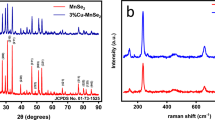Abstract
Infiltration of nanoscale electrocatalysts into Ni/yttria-stabilized zirconia (Ni-YSZ) cermets has been shown to improve the electrochemical performance of solid oxide fuel cell (SOFC) anodes. While infiltrated electrodes in SOFCs result in improved cell performance, long-term operation leads to coarsening of the infiltrated nanoparticles and negates the short-term performance improvements. This study explores the roles of humidity, temperature, and number of cycles of nanocatalyst infiltration in improving mixed conduction within the Ni-YSZ electrode. Two mixed conduction phases were studied: Gd0.1Ce0.9O2-δ (GDC) as an infiltrant into Ni-YSZ electrodes, and Ni/transition metal doped-YSZ electrodes infiltrated with Ni. Analysis of impedance data from these cells shows improved electrochemical performance in infiltrated cells with mixed conduction compared with infiltrated cells containing purely ionic and electronic conducting phases. Improved anode performance is attributed to the availability of electronic pathways through predominantly ionic-conducting phases to connect distant Ni nanoparticles and/or Ni grains.








Similar content being viewed by others
References
R.P. O’Hayre, S.-W. Cha, W.G. Colella, and F.B. Prinz, Fuel Cell Fundamentals, 1st edn. (Wiley, Hoboken, 2016).
M. Boaro and A.S. Arico, eds., Advances in Medium and High Temperature Solid Oxide Fuel Cell Technology, (Cham: Springer, 2017). https://doi.org/10.1007/978-3-319-46146-5.
A. Faes, A. Hessler-Wyser, D. Presvytes, C.G. Vayenas, and J. Van Herle, Fuel cells 9(6), 841. (2009).
E.D. Wachsman, and K.T. Lee, Science 334, 935. https://doi.org/10.1126/science.1204090 (2011).
A. Leonide, Y. Apel, and E. Ivers-Tiffee, ECS Trans 19(20), 81–109. (2009).
A. Bertei, J.G. Pharoah, D.A.W. Gawel, and C. Nicolella, ECS Trans. 57, 2527. https://doi.org/10.1149/05701.2527ecst (2013).
B. Hua, W. Zhang, M. Li, X. Wang, B. Chi, J. Pu, and J. Li, J. Power Sources. 247, 170. https://doi.org/10.1016/j.jpowsour.2013.08.060 (2014).
S. Futamura, Y. Tachikawa, J. Matsuda, S.M. Lyth, and Y. Shiratori, J. Electrochem. Soc. 164, 3055. https://doi.org/10.1149/2.0071710jes (2017).
B. Timurkutluk, C. Timurkutluk, M.D. Mat, and Y. Kaplan, Int. J. Energy Res. 35, 1048. https://doi.org/10.1002/er.1832 (2011).
J.D. Nicholas, and S.A. Barnett, J. Electrochem. Soc. 157, B536. https://doi.org/10.1149/1.3284519 (2010).
P. J. Gasper, Improving Electrochemical Performance of Nickel – Yttria Stabilized Zirconia Cermet Anodes Employing Nickel Nanoparticles. Doctoral Dissertation, Boston University, 2019.
S.N. Basu, Y. Lu, P.J. Gasper, S. Gopalan, and U.B. Pal, ECS Trans. 78, 1397. https://doi.org/10.1149/07801.1397ecst (2017).
Y. Lu, P. Gasper, U.B. Pal, S. Gopalan, and S.N. Basu, J. Power Sources. 396, 257. https://doi.org/10.1016/j.jpowsour.2018.06.027 (2018).
S.A. Barnett, B.-K. Park, and R. Scipioni, ECS Trans. 91, 1791. https://doi.org/10.1149/09101.1791ecst (2019).
L. Adijanto, R. Küngas, J. Park, J.M. Vohs, and R.J. Gorte, Int. J. Hydrog. Energy. 36, 15722. https://doi.org/10.1016/j.ijhydene.2011.09.059 (2011).
S. McIntosh, J.M. Vohs, and R.J. Gorte, J. Electrochem. Soc. 150, A470. https://doi.org/10.1149/1.1559064 (2003).
O. Costa-Nunes, R.J. Gorte, and J.M. Vohs, J. Power Sources 141, 241. https://doi.org/10.1016/j.jpowsour.2004.09.022 (2005).
T. Takeuchi, E. Bétourné, D.C. Sinclair, M. Tabuchi, A.R. West, and H. Kageyama, Solid State Ionics 120(1), 33–41. https://doi.org/10.1016/S0167-2738(99)00004-1 (1999).
Y. Lu, Improving Intermediate Temperature Performance of Ni-YSZ Cermet Anodes for Solid Oxide Fuel Cells by Infiltration of Nickel Nanoparticles, Doctoral Dissertation, Boston University (2019).
B. Mo, J. Rix, U.B. Pal, S.N. Basu, and S. Gopalan, J. Electrochem. Soc. 167(5), 54515. https://doi.org/10.1149/1945-7111/ab74bf (2020).
M.I. Osendi, and J.S. Moya, J. Mater. Sci. Lett. 7, 15. https://doi.org/10.1007/BF01729901 (1988).
B.Y. Park, R. Scipioni, D. Cox, and S.A. Barnett, J. Mat. Chem. A 8, 4099. https://doi.org/10.1039/C9TA12316D (2020).
Y.A. Chart, M.Y. Lu, and S. A. Barnett, ECS Meeting Abstracts MA2019-01 1713 (2019). https://doi.org/10.1149/MA2019-01/33/1713
M.Y. Lu, R. Scipioni, B.K. Park, T. Yang, Y.A. Chart, and S.A. Barnett, Materials Today Energy 14, 100362. https://doi.org/10.1016/j.mtener.2019.100362 (2019).
B. Mo, J. Rix, U.B. Pal, S.N. Basu, and S. Gopalan, J. Electrochem. Soc. 167(13), 134506. https://doi.org/10.1149/1945-7111/abb70f (2020).
V. Sonn, A. Leonide, and E. Ivers-Tiffée, J. Electrochem. Soc. 155, 675. https://doi.org/10.1149/1.2908860 (2008).
Y. Choi, S. Cha, H. Ha, S. Lee, H. Seo, J. Lee, H. Kim, S. Kim, and W. Jung, Nat. Nanotechnol. 14, 245. https://doi.org/10.1038/s41565-019-0367-4 (2019).
Acknowledgements
The research was funded in part by the Department of Energy, National Energy Technology Laboratory under award number DE-FE0026096. The authors acknowledge the use of the SEM facilities in the Photonics Center of Boston University.
Author information
Authors and Affiliations
Corresponding author
Ethics declarations
On behalf of all authors, the corresponding author states that there is no conflict of interest.
Additional information
Publisher's Note
Springer Nature remains neutral with regard to jurisdictional claims in published maps and institutional affiliations.
Supplementary Information
Below is the link to the electronic supplementary material.
Rights and permissions
About this article
Cite this article
Mo, B., Rix, J.G., Pal, U. et al. Exploring the Role of Humidity, Temperature, and Mixed Ionic and Electronic Conductivity on SOFC Anode Electrocatalysis. JOM 73, 2771–2780 (2021). https://doi.org/10.1007/s11837-021-04777-w
Received:
Accepted:
Published:
Issue Date:
DOI: https://doi.org/10.1007/s11837-021-04777-w




